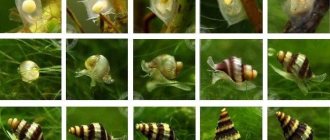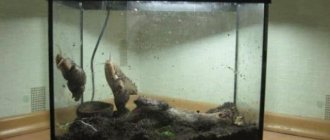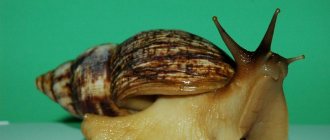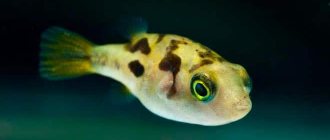Reproductive system of the Achatina snail
The African snail belongs to the class of hermaphrodites, i.e. she has male and female reproductive organs. Achatina has no division into female and male individuals. A young small snail is masculine, an adult large snail is feminine. The readiness of Achatina to reproduce is indicated by the appearance of a white tubercle on the right side of the neck.
White bump on the snail's neck
Achatina snails are oviparous mollusks, but they are also viviparous.
This is the genital organ or genital opening, since the snail is hermaphrodite. This way she signals that she is ready to reproduce. The white spot stretches out and turns into an “arrow of love” - the male genital organ. The tubercle can go deep and turn into a funnel - into the female genital organ.
The mollusk reaches sexual maturity at 7-8 months, but the worse the conditions of detention, the later its reproductive age begins.
How to create conditions for snail breeding
Proper care and comfortable living conditions allow you to grow a healthy snail and get viable offspring.
5 basic care tips
- The container containing the snail must be at least 15 liters;
- High-quality moist soil, filling 1/4 of the terrarium;
- Maintain constant temperature and humidity;
- Provide the snail with calcium and protein;
- Carry out daily and weekly cleaning of the terrarium.
A general cleaning of the terrarium or a complete replacement of the soil can serve as an incentive for reproduction in Achatina snails.
The process of snail reproduction in the natural environment
The breeding season for snails occurs only once a year, and its occurrence can be determined by how the mollusk behaves. The snail tends to move more slowly than usual, and also stop for a long time. In the case when several individuals meet, they begin some kind of mating games. At the beginning of the process, the snails make movements reminiscent of swaying, after which they rise up and, feeling each other with their tentacles, touch their soles. After this, the mollusks lie for half an hour with their soles pressed tightly. Their games continue for several more hours, after which the mating process begins.
During the process of copulation, the mollusks alternately stick calcareous needles into each other's bodies, which are called snail love arrows. Therefore, during copulation, both individuals are both males and females. Depending on the species, the time spent mating may vary. In such famous mollusks as the grape snail, this process takes no more than a few minutes, but their other relatives can spend about several hours copulating. Snails lay their eggs in prepared holes, or they can place them under the stems of vegetation. After the process of laying eggs is completed, the snail fills up its hole. The number of white eggs is usually 30-40 pieces.
After three weeks, babies are born. However, sometimes you can find snails that are viviparous mollusks. Such representatives include the giant African snail, the Malayan snail and the sand melania. You should also be aware that a third of the snails do not survive the reproduction process. You can learn how one of the most popular snails, Achatina, reproduces in this article.
Which snails should you not mate?
If you want to get healthy and viable snails, then do not mate snails from the same clutch, “parents” and “children,” “brothers” and “sisters.” Healthy and large mollusks from different families are allowed to reproduce. Mate snails of the same species and variety.
It should be noted that if you want to grow a large snail, then you should not rush into reproduction, since pregnancy completely inhibits the further development and growth of the mollusk. On the Internet you can find a recommendation that it is not advisable to mate a snail until it is one year old; Achatina is actively growing and developing.
See more similar articles:
Achatina Achatina: types of reproduction, nutrition and all about the tiger...
Preparation for reproduction
In the Achatina snail, reproduction occurs only if the aquarium or terrarium meets certain requirements. Despite the fact that Achatina are hermaphrodites, they need a partner in order to mate. To reproduce, a pair of Achatina must be moved to a separate container.
In order to breed healthy and full-fledged offspring, you need to create the following living conditions for mollusks:
- the size of the aquarium must be at least 15 liters;
- no temperature changes, it should stay around 27–28 degrees;
- It is recommended to cover the bottom of the aquarium with 100 mm thick damp coconut soil;
- for pregnant Achatina, as well as after laying eggs, add calcium to food;
- The terrarium must be kept clean.
The following is used as a supplement containing calcium:
- chalk stone;
- mineral stone;
- sepia;
- small shell rock.
Gender of the snail
The question of determining the sex of an individual is of interest to every breeder; as stated earlier, they have no sexual differences; it is impossible to determine the sex and divide snails into male and female. Achatina cannot reproduce alone, without a partner; a companion is needed for mating. The eldest large individual becomes the female. This is due to the fact that pregnancy requires a lot of physical strength, therefore, the strongest representatives are selected in order to ensure healthy offspring.
Stimulation of reproduction
Stimulating a mollusk to reproduce consists primarily of organizing all the necessary conditions related to preparation for mating. The terrarium should be thoroughly washed and cleaned; if the soil is dry and its thickness does not reach 10 cm, then it should be replaced. The soil must be clean. Artificial ponds should be temporarily removed from the terrarium. It is also important to make sure that only healthy Achatina mates.
What to do if they don’t bear offspring?
The conditions for keeping Achatina at home have been met, the terrarium is ready, the animals are healthy, but there are no offspring. What to do in this case? Perhaps everything is not well organized, as it seemed, there are reasons for the lack of offspring.
- Snails do not receive adequate balanced nutrition and additional feeding.
- The thickness of the soil in the terrarium is small (4 cm), there is simply no place to lay eggs.
- Dirty soil is the reason for unsuccessful mating; it is simply difficult for them to reproduce in such conditions and simply live.
The breeding of pets should be taken responsibly. It is not enough to create the necessary conditions for the reproduction of Achatina snails; you need to decide where to distribute future small snails. Remember, breeding snails to look at and be touched for pleasure is a stupid idea.
Video about snail breeding
Which Achatina snails cannot be mated?
- mollusks from the same clutch;
- snails that grow quickly.
Mating of individuals from the same clutch can cause various mutations and deviations in the development of future offspring.
If it is noticed that the mollusk and the shell are actively growing and increasing in size, then mating should be postponed. This process can occur up to the age of 1 year.
How does the Achatina snail reproduce?
For mating, snails are placed in a separate container. If the snails are the same size, then fertilization occurs bilaterally, if the partners are different in size, then fertilization will be unilateral. The larger snail takes on the role of the female.
With age, the body of an adult Achatina produces more eggs than sperm.
A young snail produces more male sex cells than female ones, so for reproduction, a young one is added to adult snails.
The mating process in Achatina lasts about two hours. They gently touch their genitals, crawl and kiss each other. Whirling in such a love dance, sperm exchange and fertilization occur. Sperm is stored in the body of the mollusk for more than two years; under favorable conditions, the snail can lay eggs every month.
Caring for a pregnant snail
Snail pregnancy lasts differently for different species of Achatina, on average from one to two weeks. The snail then resolves, laying 50 to 300 eggs.
Pregnancy in an Achatina snail takes a lot of strength and energy; often after mating, the mollusks become inactive and sleep more buried in the ground. The snail stops growing and forming. These days you need to provide a sufficient amount of calcium, this can be food chalk, sepia or calcium mixtures. Feed the pregnant Achatina grain mixtures, vegetables and protein supplements. See feeding recipes here. A balanced diet will allow the birth of healthy offspring.
- Maintain a warm and humid climate in the terrarium, and carefully wash the body and shell of the mollusk.
A week after fertilization, several eggs can be seen in the breathing hole on the side of the snail. This is a future clutch that will hatch in two weeks. The Achatina snail lays a clutch of eggs in the ground, but there are cases when the clutch is scattered over the surface of the ground.
In the large Achatina family there are viviparous snails, for example Achatina Zanzibarica and lemon Achatina. They do not lay eggs, but produce 20-30 snails up to 9 mm.
How do aquarium snails reproduce?
Snails reproduce in an equally interesting way in an aquarium. They differ from their terrestrial relatives by the presence of a long breathing tube, which allows them to breathe oxygen without rising to the surface of the water. Unlike land snails, which are hermaphrodites, their aquatic relatives are heterosexual creatures. It is practically impossible to distinguish a male from a female by external signs.
Reproduction in aquarium snails occurs exclusively in an aquatic environment, and they lay eggs in the air - above the water line. For example, ampullaria lay their eggs on the walls of the aquarium, since outside the aquarium these snails will simply die. Before laying, the female ampularia spends a long time examining the surrounding area on the glass of the aquarium.
As soon as she finds a suitable place, she begins to throw her eggs, which stick to the glass. The result is something similar to a grapevine. After just 3 weeks, these eggs hatch into babies. As soon as they are born, they fall into the water. The start has been given to the new generation!
Laying eggs
The eggs of the Achatina snail are white, oval in shape, about 4-6 mm, enclosed in a calcium shell. The number of eggs in a clutch increases by several dozen with each subsequent clutch and can reach 400 pieces.
You should not touch snail eggs with your hands if you want to get offspring. The warmth of our hands is destructive for them.
How to care for snail eggs
Prepare a small container and add a layer of moist soil to the bottom. Then use a spoon to dig up the masonry and move it to a container. Cover the top with soil and moisten it. Try to avoid temperature fluctuations (26-28 degrees) and drying out of the soil. After 7-10 days, small snails will hatch from the eggs. Read more about snail masonry here.
False masonry in Achatina
The first clutch of snails is a trial one, i.e. unfertilized, it contains no more than 10-15 eggs. They are translucent and not enclosed in a shell. That's why snail breeders call them fat eggs.
A false clutch is a harbinger of a real one if the snail has a pair. Often fat eggs are laid by lonely Achatina. If you do not plan to reproduce Achatina snails, then it is safer to freeze all clutches. Cases of self-fertilization in African snails are common. Today, snail caviar, which can be prepared at home, is gaining great popularity among gourmets.
How pregnancy affects snail health
Most often, in the natural habitat, pregnancy in Achatina occurs without complications, but in home conditions, unforeseen difficulties are possible.
- Pregnancy inhibits the growth and development of mollusks
- The formation of egg clutch consumes calcium and protein reserves;
- The snail shell becomes thinner, exfoliates and becomes deformed;
- It hibernates if the snail is young and small in size.
Before you start breeding Achatina snails, you must clearly understand that several hundred snails hatch from one clutch, which require a large terrarium, proper care and nutrition. Read about keeping small Achatina. African snails grow quickly and are not so easy to sell or house, and the more snails, the higher the costs. Therefore, breeding snails in order to admire the babies is stupid and imprudent.











